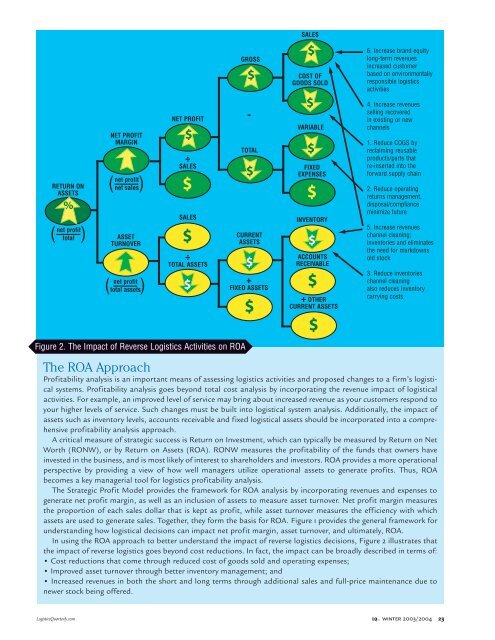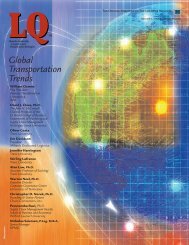Reverse Logistics - Logistics Quarterly
Reverse Logistics - Logistics Quarterly
Reverse Logistics - Logistics Quarterly
Create successful ePaper yourself
Turn your PDF publications into a flip-book with our unique Google optimized e-Paper software.
RETURN ON<br />
ASSETS<br />
%<br />
net profit ( total )<br />
The ROA Approach<br />
Profitability analysis is an important means of assessing logistics activities and proposed changes to a firm’s logistical<br />
systems. Profitability analysis goes beyond total cost analysis by incorporating the revenue impact of logistical<br />
activities. For example, an improved level of service may bring about increased revenue as your customers respond to<br />
your higher levels of service. Such changes must be built into logistical system analysis. Additionally, the impact of<br />
assets such as inventory levels, accounts receivable and fixed logistical assets should be incorporated into a comprehensive<br />
profitability analysis approach.<br />
A critical measure of strategic success is Return on Investment, which can typically be measured by Return on Net<br />
Worth (RONW), or by Return on Assets (ROA). RONW measures the profitability of the funds that owners have<br />
invested in the business, and is most likely of interest to shareholders and investors. ROA provides a more operational<br />
perspective by providing a view of how well managers utilize operational assets to generate profits. Thus, ROA<br />
becomes a key managerial tool for logistics profitability analysis.<br />
The Strategic Profit Model provides the framework for ROA analysis by incorporating revenues and expenses to<br />
generate net profit margin, as well as an inclusion of assets to measure asset turnover. Net profit margin measures<br />
the proportion of each sales dollar that is kept as profit, while asset turnover measures the efficiency with which<br />
assets are used to generate sales. Together, they form the basis for ROA. Figure 1 provides the general framework for<br />
understanding how logistical decisions can impact net profit margin, asset turnover, and ultimately, ROA.<br />
In using the ROA approach to better understand the impact of reverse logistics decisions, Figure 2 illustrates that<br />
the impact of reverse logistics goes beyond cost reductions. In fact, the impact can be broadly described in terms of:<br />
• Cost reductions that come through reduced cost of goods sold and operating expenses;<br />
• Improved asset turnover through better inventory management; and<br />
• Increased revenues in both the short and long terms through additional sales and full-price maintenance due to<br />
newer stock being offered.<br />
<strong>Logistics</strong><strong>Quarterly</strong>.com<br />
NET PROFIT<br />
MARGIN<br />
net profit ( net sales)<br />
ASSET<br />
TURNOVER<br />
net profit ( total assets)<br />
NET PROFIT<br />
$<br />
÷<br />
SALES<br />
$<br />
SALES<br />
$<br />
÷<br />
TOTAL ASSETS<br />
Figure 2. The Impact of <strong>Reverse</strong> <strong>Logistics</strong> Activities on ROA<br />
$<br />
GROSS<br />
$<br />
-<br />
TOTAL<br />
$<br />
CURRENT<br />
ASSETS<br />
$<br />
+<br />
FIXED ASSETS<br />
$<br />
SALES<br />
$<br />
COST OF<br />
GOODS SOLD<br />
$<br />
VARIABLE<br />
$<br />
FIXED<br />
EXPENSES<br />
$<br />
INVENTORY<br />
$<br />
ACCOUNTS<br />
RECEIVABLE<br />
$<br />
+ OTHER<br />
CURRENT ASSETS<br />
$<br />
6. Increase brand equity<br />
long-term revenues<br />
increased customer<br />
based on environmentally<br />
responsible logistics<br />
activities<br />
4. Increase revenues<br />
selling recovered<br />
in existing or new<br />
channels<br />
1. Reduce COGS by<br />
reclaiming reusable<br />
products/parts that<br />
re-inserted into the<br />
forward supply chain<br />
2. Reduce operating<br />
returns management,<br />
disposal/compliance<br />
minimize future<br />
5. Increase revenues<br />
channel cleaning;<br />
inventories and eliminates<br />
the need for markdowns<br />
old stock<br />
3. Reduce inventories<br />
channel cleaning<br />
also reduces inventory<br />
carrying costs<br />
LQ winter 2003/2004<br />
23







